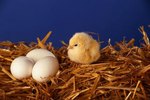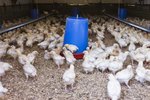Broiler chickens, also referred to as fryers or fryer chickens, are raised for meat consumption. Broilers are generally marketed at 4 to 10 weeks of age depending on preferred body weight. The needed equipment for raising broiler chickens are minimal, requiring only adequate housing, food and water equipment and heat lamps if raising broilers from chicks. Raising broilers require daily care of feeding, watering and maintaining a sanitary housing area.
Types

When raising broilers for meat production, you will want to choose chickens that will quickly grow meaty breasts and thighs. These chickens will need to have strong bones in order to carry this extra weight. According to the University of Alaska Fairbanks, the best type of chicken to raise that meets these requirements are a crossbred variety of White Cornish and White Plymouth Rock. This crossbreed will achieve a weight of 3 1/2 to 4 lbs. at the age of 8 weeks, and many males will attain a weight of 3 1/2 lbs. by the time they reach 7 weeks of age.
Brooding

During the first few weeks of life, baby chicks will need to have a heat source, as they are too young to regulate their body temperature. This stage is called the brooding period. For the first month, keep chicks indoors providing 1 square foot of floor space for each bird. Provide 2 square feet per bird in the second month. Place bedding materials, such as wood shavings, on the floor for litter. Replace the shavings often when it becomes wet and hard packed. Maintain a temperature of 90 to 95 degrees Fahrenheit by placing a light source such as an infrared bulb or an electric heat lamp at one end of the housing area. Lower the temperature by 5 degrees Fahrenheit weekly.
Housing

When the broilers are fully feathered, at around 3 to 5 weeks of age, they seldom require heat. When the broilers are over 4 weeks of age, maintain a temperature of 60 to 75 degrees Fahrenheit. In extremely cold weather, supplemental heating may be required, and in very hot weather, use fans to circulate the air. House broilers in a broiler house with 4 to 6 inches of litter or outdoors in a fenced in area with a shelter.
Feed and Water

For the first four weeks, feed baby chicks a starter feed with 23 percent protein. At four to eight weeks, feed a grower feed with 19 percent protein. Keep feeders full at all times when starting baby chicks, until they learn to eat. When they start eating, keep feeders about three-fourths full to avoid feed waste. Broilers must have fresh water at all times, and you should change the water every day. Clean the water feeder once a day as chickens will inevitably drop feed into their water. If baby chicks cannot find their water, gently place their beaks in the water.
Health

Maintain a clean housing unit and change wet litter to prevent breast blisters and diseases such as internal parasites. Purchase feed that has a coccidiostat, which is a medication to prevent coccidiosis. This disease commonly kills young chicks by attacking the intestinal tract. To prevent feather pecking and cannibalism, make sure that the birds are not crowded, are getting the proper nutrients, have adequate ventilation and plenty of food and water.
Resources
Photo Credits
-
fatness of chicken image by Witold Krasowski from Fotolia.com
Writer Bio
Billie Abbott is a freelance writer, producing articles for numerous websites, including ParentDish and Gadling. She specializes in topics about gardening, animals, parenting and travel.




